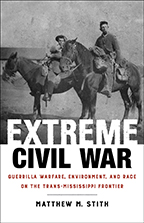
232 pages / 5.50 x 8.50 inches / 6 halftones, 1 map
History / United States - Civil War Period | History / United States - Southern History
Matthew M. Stith is assistant professor of history at the University of Texas at Tyler.
“Despite the vast amount written on the Civil War, imaginative scholars find new aspects of the conflict and sources to explore them. . . . While the area studied is small and seemingly on the fringe of the Civil War, the issues Stith raises have much to say about the nature of the conflict between North and South. Highly recommended.”—CHOICE
“A richly textured account of a region and its people at war . . . . Stith’s chapters deftly integrate conventional military history with cultural, racial, and environmental history--bringing together in fresh ways several key sub-fields in Civil War history. . . . It is hard to imagine that anyone could produce a more exhaustive or compelling account of the guerrilla conflict in the western Trans-Mississippi frontier.”—Journal of Military History
“[Extreme Civil War’s] powerful narrative builds upon a broad range of primary sources. . . .Stith describes the borderland conflict as a ‘war in the margins,’ and that phrase also provides a fitting illustration of how this synthesis reaches across many subfields of historical study. . . . Its sharp focus and splendid execution make it a welcome addition to the scholarship of the border West.”—Jeremy Neely, Missouri Historical Review
“Extreme Civil War considerably expands the geographical area under consideration by border war scholars and enhances our understanding of just how frightening and deadly the war could be for civilians. The book also succeeds in making meaningful connections with newer branches of study (like environmental history). . . . Extreme Civil War is highly recommended reading.”—Civil War Books and Authors
“The author writes well, and he has researched scores of primary sources to assemble a compelling account of the miserable existence that many families on both sides were forced to endure during the war. This book is highly recommended for Civil War buffs, especially those who are interested in the Trans-Mississippi Theater.”—Journal of America’s Military Past
“Stith’s book . . . is a timely outgrowth of the fairly open and fertile ground of guerrilla studies. . . . A well-researched study.”—North Carolina Historical Review
“A ground breaking study of the protracted irregular warfare in the Trans-Mississippi. . . . Stith makes his case well, drawing evidence both from official documents and published materials, as well as from an extraordinary number of first-hand accounts by civilians, government officials, and soldiers.”—NYMAS Review
“This well-written and engaging book should become required reading for those who persist in disputing whether the Civil War was a total war or not. For those who lived along the frontier where Missouri and Arkansas meet Kansas and Oklahoma, the war experience was of course total, and devastating. Gender, ethnicity, race--all made no difference to those who took advantage of the absence of civilized authority to wage a personal war on their own horrific terms. This work thus provides an insight not only into the brutality of the war years, but also the lingering bitterness that plagued the region for years to come.”—Richard B. McCaslin, author of Tainted Breeze: The Great Hanging at Gainesville, Texas, 1862
“Matthew Stith’s Extreme Civil War is a concise yet vivid portrayal of the Civil War along the borders of Missouri, Kansas, Arkansas, and Indian Territory. In clear, compelling language, Stith reveals that on the Trans-Mississippi frontier, the war took on a unique character, where civilians, guerrillas, and regular armed forces unceasingly fought for control over the land and its resources, leaving the region a literal ‘burned over’ district, largely depopulated and left to nature to reclaim. Easy to read, deeply researched, and filled with first-hand accounts, Stith’s book is a welcome and unique contribution to Civil War studies.”—Lisa M. Brady, author of War upon the Land: Military Strategy and the Transformation of Southern Landscapes during the American Civil War
“Here is a book American Civil War scholars have needed for some time. Stith injects the important role of environmental history into one of the Civil War South’s vicious guerrilla wars and establishes this as an important area of exploration for future studies of irregulars. Thanks to Stith, the story of the western Trans-Mississippi region during the war of the 1860s will never be the same.”—Barton A. Myers, author of Rebels against the Confederacy: North Carolina’s Unionists
Found an Error? Tell us about it.